-

人教版新目标初中英语八年级下册He said I was hard-working教案2篇
This activity introduces some new vocabulary and provide oral practice using the target language.Task 1 . Ask four students to stand in front of the class, and the teacher asks them the following questions as a reporter.1.What are you going to do when you grow up?2.What are you going to do next week?3.What are going to do after school?The students will give different answers, then ask a good student to report what they said.I am going to e a doctor.What did she say?----------She said she was going to be a doctor.I am going to have a party on Friday night.What did he say?-------He said he was going to have a party on Friday night.I am going to do my homework.What did she say ?------ She said she was going to do her homework.I am going home after school.What did she say?-----She said she was going home after school.Say In this unit we are going to learn to use words like to report what someone said.Task 2. Read the instructions. Then ask a student to read the four questions. And write the words on the Bb. Explain what soap opera is.Task 3. Ask the students to Look at the pictures, point out the TV screens in the picture. Ask one girl to read what Marcia said.What did Marcia say? She said She said she was having a surprise party for Lana on Friday night. Repeat the other pictures in the same way.Activity3. Listen and number the pictures in activity 1a.

人教版新目标初中英语八年级下册What were you doing when the UFO arrived教案2篇
(一).知识方面: 1.培养学生能运用过去进行时来描述、谈论过去某个时间正在发生的事情或动作的意识和能力,能就过去某个时间正在发生的动作做出正确的描述。 2.培养学生的想象力和角色扮演的合作能力。 3.培养学生讲述过去发生的事情经过的能力。能正确运用一般过去时来讲述故事。 (二).技能方面: 1.本单元的语言目标是Talk about past events and tell a story(谈论过去的时间和讲述一个故事),围绕这一目标,要涉及句型: What were you doing when the UFO arrived? ----I was sitting in the barber’s chair. The barber was cutting my hair. 因此必须学习standing、studying、cleaning、sleeping、cooking、making、eating、cutting、等表示地点的词,以便为上述句型提供语言材料。2.学习过去进行时的有关知识。Was/were+现在分词,是该时态的表达式。 3.在学习过程中,要区分The boy was walking down the street when the UFO landed.和While the boy was walking down the street, the UFO landed.这两种由when和while引导的状语从句的句型结构。注意它们的不同。

人教版新目标初中英语八年级下册Why don’t you get her a scarf教案
教师带领学生复习有关描述宠物的词汇,采用教师提问学生回答的方进行。如:T:What animals do you think would be good pets?What animals do you think would be bad pets?What do you think are good animals for a six-year-old child?然后学生进行 pairwork 练习。Task two: 师生互动,学习探究 1、播放3a部分的录音,引导学生一边听录音,一边跟读。2、通过听录音学生回答以下问题:Why do you think pot-bellied pigs are popular?What are the advantages and disadvantages of keeping such a pet?教师对学生的回答进行及时点评。3.学习范文,学习重点短语,为下步的模仿写作提供语言素材。T :1. )Have you ever kept a pig as a pet?Do you like pigs? St.:No.…Why don’t you like to keep a pig? St: No.They’re too dirty and lazy(Do you know in some foreign countries like Hollyland, Australia,pigs are the most popular pet.there’s a kind of pig.(图)it has an interesting name? it ‘s called a pot-bellied pig.) Now,let’s learn an article about this kind of interesting pet.2.)play the tapeSt.:Listen and repeat3.)show some Qs on computer(本子St.: read silently,then answerthe Qs(本子)4.)Ask ss. Close book and retell this passage.(what is a pot-bellied pig? Is it a good or bad pet? ) St.: retell it to each other“A pot –bellied pig is a popular pet now…”5.read the article together.St.:.practice reading

人教版新目标初中英语八年级下册Would you mind turning down the music教案
Step 4. Group work (4)1. Ask a pair of students to read the dialogue. Say, This activity provides speaking, listening and writing practice using the target language.2. Ask students to complete the work in groups.3. Check the answers with the whole class. 4. Explain some of the language points. Step 5. Word review (Self check 1)1. Ask students to read the words and the phrases given. 2. Fill in the blanks with proper forms of these words to complete the sentences. 3. Check the answers with the whole class. Homework:Do activity 2 on page 57 after class. Period 6Teaching aims: 1. Teach vocabulary words and the useful expressions. 2. Enable the students to learn etiquette in different culture. 3. Help the students learn how to behave politely in public places and in daily life. Teaching procedures:Step 1. RevisionHelp students to review the function of making requests through a free talk. Then lead them to the topic of etiquette. Explain the meaning of etiquette. Or, ask students to look it up in the dictionary. Step 2. Pre-reading (Section 1)1. Ask students to read the picture and make a list with their partner about how many rules of etiquette can be seen being broken.

人教版新目标初中英语九年级上册Teenagers should be allowed to choose their own clothes教案2篇
Step 1 Greeting Greet the class and check the homeworkStep 2 A duty report The S on duty gives a report on the rules in his home and lead in 3a “Sun Fei’s and Wu Yu’s rules” Step 3 ReadingSs read the conversation and write the two girls’ rules in the chart. Check the answers.Get Ss to read after the tape and then read aloud by themselves. Then, T explains the language points.Step 4 Pairwork 3bRole play. Use the information in chart to practice with the conversation in 3a covered. They can look at the sample conversation in the right box.Step 5 Task 2 “Who’s the best reporter?”Make a survey by asking any 5 students the questions in the chart in activity 4. Then give out a report about it. See who is the best reporter? And the best reporter will get a nice ball-pen.Step 6 Summary and homework:Write out the report in your exercise-books.Period ThreeStep 1 Greeting and a duty reportThe S gives a duty report talking about his experience of being late for school. Lead in the question “Do you ever get to school late? How often do you get to school late? Always, usually, sometimes, or never?Step 2 1a Get Ss to finish writing.Step 3 Pairwork 1b Get Ss to talk about their answers with their partners using the sample conversation in the box on the right.Step 4 Listening practice2a Lead-in: What will happen if you get to school late? What about Peter? Let’s listen to a conversation between Peter and his father. Get Ss to finish 2a (As usual, for the first time, Ss only listen.) Check the answers.

人教版新目标初中英语九年级上册I like music that I can dance to教案
教学目标: 1. Express preferences2. Talk about one’s likes and dislikes and the reasons3. Learn to express one’s opinions 4. Learn to write a reply 语言功能: 1) Talk about one’s preferences, using t he relative clause2) Talk about people’s likes and dislikes and the reasons3) Talk about opinions语言结构: Relative clauses with that and who语言目标:What kind of music do you like?I like music that I can sing along with.I love singers who write their own music.We prefer music that has great lyric.重点词汇及短语:heart, photography, interest, class, whatever, miss, okay, expect, sweet, taste, itself, laboratory, cancer, increase, biscuit, main, care, prefer… to…, remind somebody of …, dance to, sing along with, be sure to, interest somebody, make somebody adj., to be honest, suit somebody, on display, catch up教学重难点:What do other people think of the different kinds of things? How to express one’s opinions? 学习方式:讨论,合作学习情感目标:通过本单元的学习,能提高学生的艺术鉴赏能力和审美情趣,并引导学生养成健康的饮食习惯。课时安排5课时第一课时:Section A: 1a-2c第二课时:Section A : 3a-4第三课时:Section B:1-2c, Self check2第四课时:Section B: 3a-4, Self check1第五课时:Self check ReadingI like music that I can dance to.

人教版新目标初中英语九年级上册How do you study for a test教案2篇
内容提示本单元主要内容是学会利用verb十by/with gerund表示方式方法来讨论学习英语的策略,认识自己在学习方面的长处和不足。初步了解现在完成时的结构和用法。现在完成时由助动词have/has+动词的过去分词构成,主要表示过去发生的某一动作对现在仍有影响或造成的后果,常与already,yet,just,ever,never等副词连用。教学目标一、学习目标(Language Goal) 1. Talk about how to study . 学会讨论各种学习方法和策略。2. Find out your suitable learning methods. 找出适合自己的学习方法。 二、语言结构(Language Structures) 1. Verb + by with gerund by+动名词短语 表示“通过…途径,方法” 2. How questions have引导的特殊疑问句 三、目标语言(Target Language) 1. How do you study for tests ? 你是怎样准备考试的?Well , I study by working with my classmates. 哦,我和同学们一起学习。2. Have you ever studied with a group ? 你曾经参加过学习小组吗?Yes , I have . I’ve learned a lot that way . 是的,参加过。通过这种方式我学了许多。

人教版新目标初中英语九年级下册By the time I got outside, the bus had already left教案
Ⅰ. Teaching Aims and Demands1. Knowledge Objects(1) Key Vocabularyoversleep(2) Target LanguageWhat happened?I overslept. And by the time I got up, my brother had already gotten in the shower.2. Ability Objects(1) Teach the students to use the new words.(2) Train the students to narrate past events with the Past Perfect Tense.(3) Train the students' listening and speaking skills with the target language.3. Moral ObjectIt’s a good habit to go to bed early in the evening and get up early in the morning. So you’ll never be in a hurry in the morning.Ⅱ. Teaching Key Points1. Key Vocabularyoversleep2. Target LanguageNarrate past events with the Past Perfect TenseⅢ. Teaching Difficult Points1. Train the students to narrate past events with the Past Perfect Tense.2. Train the students to understand the target language in spoken conversation.Ⅳ. Teaching Methods1. Thinking of examples from the students' real lives.2. Making sentences by looking at the pictures.Ⅴ. Teaching AidA tape recorderⅥ. Teaching ProceduresStep I Revision1. Revise the language points in Unit 8.Ask some questions like this: What volunteer work would you like to do?Help the students to answer, I’d like to…/I love to…/I hope to2. Practice the dialogue in Activity 3c on page 62 again. Get students to role play the similar dialogues with the following.

人教版新目标初中英语九年级下册Rainy days make me sad教案
1. 教材分析本单元以how do things affect you?为话题, 从颜色、天气、音乐、广告、产品等方面谈论了外界事物如何影响人的心情。要求学生掌握表达某物或某事给人带来的感觉、看法或影响等。共设计了四个部分的内容:Section A 该部分有4个模块:第一模块围绕Which restaurant would you like to go to?这一话题展开思维(1a)、听力(1b)、口语(1c)训练;第二模块围绕How does music affect you? 进行听力(2a-2b)、口语训练(2c);第三模块继续围绕how do colors in the restaurant affect you这一话题展开训练,训练形式为阅读和问题体验(3a)和小组活动(3b);第四模块仍就How do things affect you这一话题以调查的形式展开讨论。Section B该部分有4个模块:第一模块围绕产品广告对人们的影响这一话题以“配对”(1a)与“列举”(1b)两种形式展开训练;第二模块继续围绕How do things affect you? 进行听力(2a-2b)、口语对话训练(2c);第三模块围绕“Advertising”这一话题展开阅读(3a-3b)和写作(3c)训练;第四模块围绕How posters affect you这一话题以口语训练形式展开小组活动。

人教版新目标初中英语九年级下册I’ll help clean up the city parks教案
Talk about offering help (P60)I’ll help clean up the city parks.A: I’d like to work ...B: You could help ...Talk about ways to tell people about the Clean-Up Day (P61)We need to ...We can’t ...I’ll ...Talk about the work the volunteers do (P62)These three students all volunteer their time to help other people.Somebody loves to ... / helps ... / plans to ... / wants to ...A: What do you like doing?B: I like ... A: What kind of volunteer work do you think I could do?B: You could ...1. 重点词汇advertisement, fix, repair, pleasure, blind, deaf, shut, carry, specially, fetch2. 认读词汇hunger, homeless, cheer, clean-up, sign, establish, major, commitment, elementary, veterinarian, coach, similar, call-in, strategy, disabled, organization, unable, support, appreciate, donation, part of speech, pronoun, adverb, preposition, conjunction, donate, Jimmy, Sally3. 词组clean up, cheer up, give out, put off, set up, think up, take after, fix up, give away, put up, hand out, work out, at once

人教版新目标初中英语九年级下册You’re supposed to shake hands教案
教学目标:1. 掌握本单元一些重点词汇的写法和用法。2. 学会自如谈论餐桌礼仪。Step 1 RevisionAsk some students to retell the customs at the table in France in the passage in 3a.Step 2 Self checkPart 1. Fill in each bland with the correct word given. Students do the exercises by themselves at first. Then check the answers. Ask the students to comprehend the sentences and help them point out uses of some words, like “arrive (at / in) sw., spend time / money on sth , spend time / money (in) doing sth.”Part 2. Read about Fan Ling’s experience in a western restaurant. Understand the passage. Point out some key points in the passage.1. be / get used to doing sth. 习惯做某事2. begin with = start with 以….开头3. crowd v. 挤满,塞满 the crowd 人群 crowded adj. 拥挤的Then students discuss about how she would solve her problem. Ask some to share their stories with others.Part 3. Complete the crossword by looking at the sentences on the left. Then check the answers.
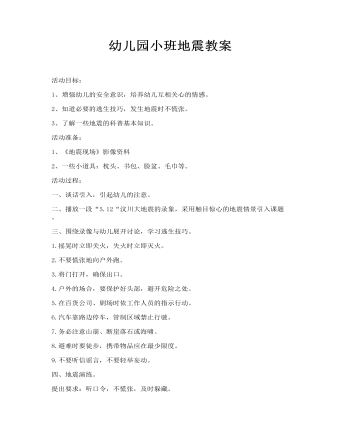
幼儿园小班地震教案
二、播放一段“5.12“汶川大地震的录象,采用触目惊心的地震情景引入课题。三、围绕录像与幼儿展开讨论,学习逃生技巧。1.摇晃时立即关火,失火时立即灭火。2.不要慌张地向户外跑。3.将门打开,确保出口。4.户外的场合,要保护好头部,避开危险之处。5.在百货公司、剧场时依工作人员的指示行动。6.汽车靠路边停车,管制区域禁止行驶。
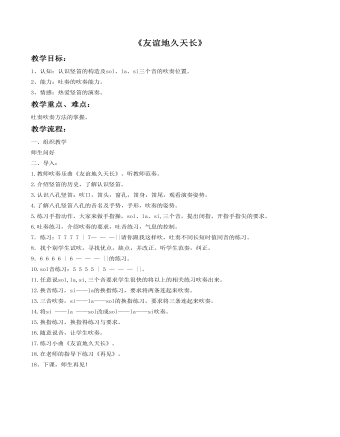
《友谊地久天长》教案
教学流程: 一、组织教学师生问好二、导入:1.教师吹奏乐曲《友谊地久天长》。听教师范奏。2.介绍竖笛的历史,了解认识竖笛。3.认识八孔竖笛:吹口,笛头,窗孔,笛身,笛尾,观看演奏姿势。4.了解八孔竖笛八孔的音名及手势,手形,吹奏的姿势。5.练习手指动作,大家来做手指操,sol、la、si,三个音,提出闭指,开指手指尖的要求。6.吐奏练习,介绍吹奏的要求,吐音练习,气息的控制。7.练习:7 7 7 7 | 7———||请你跟我这样吹,吐奏不同长短时值同音的练习。8.找个别学生试吹,寻找优点,缺点,并改正。听学生范奏,纠正。9.6 6 6 6 | 6 ——— ||的练习。10.sol音练习:5 5 5 5 | 5 ——— ||。11.任意说sol,la,si,三个音要求学生很快的将以上的相关练习吹奏出来。12.换音练习,si——la的换指练习,要求将两条连起来吹奏。13.三音吹奏,si——la——sol的换指练习,要求将三条连起来吹奏。14.将si ——la ——sol改成sol——la——si吹奏。15.换指练习,换指得练习与要求。16.随意说音,让学生吹奏。17.练习小曲《友谊地久天长》。18.在老师的指导下练习《再见》。18、下课,师生再见!
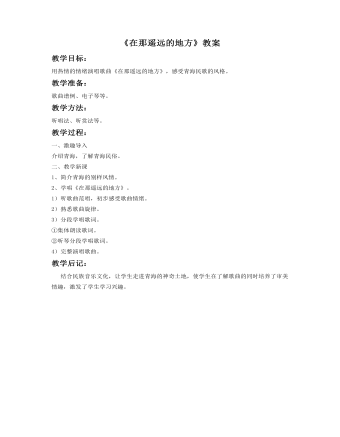
《在那遥远的地方》教案
教学目标:用热情的情绪演唱歌曲《在那遥远的地方》,感受青海民歌的风格。教学准备:歌曲谱例、电子琴等。教学方法:听唱法、听赏法等。教学过程:一、激趣导入介绍青海,了解青海民俗。二、教学新课1、简介青海的别样风情。2、学唱《在那遥远的地方》。 1)听歌曲范唱,初步感受歌曲情绪。2)熟悉歌曲旋律。3)分段学唱歌词。①集体朗读歌词。②听琴分段学唱歌词。4)完整演唱歌曲。教学后记:结合民族音乐文化,让学生走进青海的神奇土地,使学生在了解歌曲的同时培养了审美情趣,激发了学生学习兴趣。
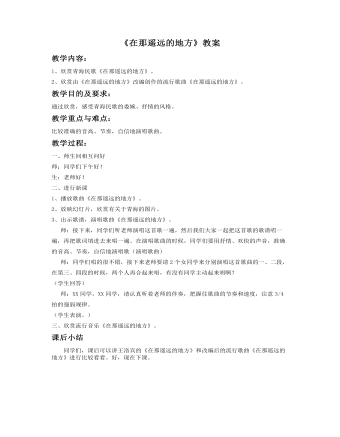
《在那遥远的地方》教案
教学过程:一、师生间相互问好师:同学们下午好!生:老师好!二、进行新课 1、播放歌曲《在那遥远的地方》。2、放映幻灯片,欣赏有关于青海的图片。3、出示歌谱,演唱歌曲《在那遥远的地方》。 师:接下来,同学们听老师演唱这首歌一遍,然后我们大家一起把这首歌的歌谱唱一遍,再把歌词填进去来唱一遍。在演唱歌曲的时候,同学们要用抒情、欢快的声音,准确的音高、节奏,自信地演唱歌(演唱歌曲) 师:同学们唱的很不错,接下来老师要请2个女同学来分别演唱这首歌曲的一、二段,在第三、四段的时候,两个人再合起来唱,有没有同学主动起来唱啊?(学生回答) 师:XX同学,XX同学,请认真听着老师的伴奏,把握住歌曲的节奏和速度,注意3/4拍的强弱规律。(学生表演。)三、欣赏流行音乐《在那遥远的地方》。
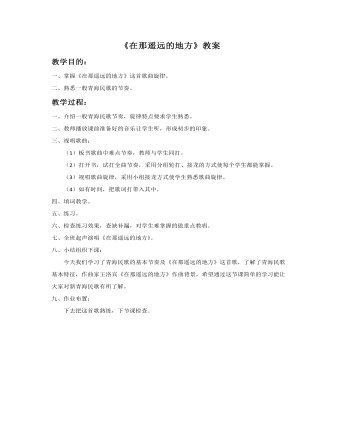
《在那遥远的地方》教案
教学过程:一、介绍一般青海民歌节奏,旋律特点要求学生熟悉。二、教师播放课前准备好的音乐让学生听,形成初步的印象。三、视唱歌曲: (1)板书歌曲中难点节奏,教师与学生同打。 (2)打开书,试打全曲节奏,采用分组轮打、接龙的方式使每个学生都能掌握。 (3)视唱歌曲旋律,采用小组接龙方式使学生熟悉歌曲旋律。 (4)如有时间,把歌词打带入其中。四、填词教学。五、练习。六、检查练习效果,查缺补漏,对学生难掌握的做重点教唱。七、全班起声演唱《在那遥远的地方》。八、小结组织下课: 今天我们学习了青海民歌的基本节奏及《在那遥远的地方》这首歌,了解了青海民歌基本特征,作曲家王洛宾《在那遥远的地方》作曲背景,希望通过这节课简单的学习能让大家对新青海民歌有所了解。九、作业布置: 下去把这首歌熟练,下节课检查。
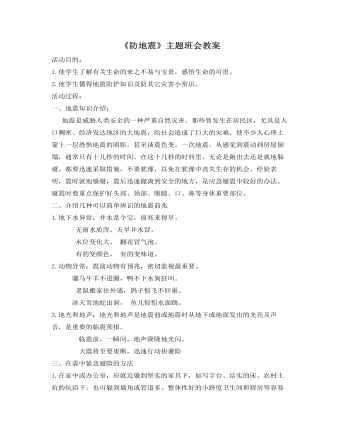
《防地震》主题班会教案
活动目的:1.使学生了解有关生命的来之不易与宝贵,感悟生命的可贵。2.使学生懂得地震防护知识及防其它灾害小常识。活动过程:一、地震知识介绍:地震是威胁人类安全的一种严重自然灾害。那些曾发生在居民区,尤其是人口稠密、经济发达地区的大地震,给社会造成了巨大的灾难,使不少人心理上蒙上一层恐惧地震的阴影,甚至谈震色变。一次地震,从感觉到震动到房屋倒塌,通常只有十几秒的时间。在这十几秒的时间里,无论是跑出去还是就地躲避,都要迅速采取措施,不要犹豫,以免在犹豫中丧失生存的机会。经验表明,震时就地躲避,震后迅速撤离到安全的地方,是应急避震中较好的办法。避震时要重点保护好头部、颈部、眼睛、口、鼻等身体重要部位。

歌剧《白毛女》选段教案
教学过程:一、鉴赏对比《北风吹》《扎红头绳》{过渡语}师:刚才我们欣赏了歌剧《白毛女》的几个著名片段,你能在刚才的歌曲中找一找歌剧需要具备的要素吗?同学们来比较一下:北风吹和扎红头绳表现出的不同的音乐要素?下面由同学们来一起分组讨论: 曲 目 速度 力度 音色 演唱形式 表达情绪 音乐特点《北风吹》 中 中弱 女高音 女声独唱 天真、期盼 下行休止符运用《扎红头绳》 快 中 女高音 对 唱 欢快、活泼 旋律跳进,节奏密集设计意图:学生通过选用合适的音乐为故事配音的活动,更深刻地认识音乐在其中的作用。师:刚从我们的小演员的表现中我们所感受到不同的音乐情绪:天真期盼、欢快、悲恸。音乐根据不同需要可以刻画出不同的艺术形象表达不同的情感。我们还知道了对塑造刻画音乐形象起重要作用的是音乐作品中的音乐要素。二、情景剧编创老师简析:(导出情景剧表演) 1,师:你能说一说他们的声音有什么特点吗?(喜儿:声音清脆、甜美 杨:浑厚、低沉)2. 出示歌谱,学生模仿二人的声音朗读歌词。 再次听赏歌曲,体会两首歌曲的旋律特点。(《北风吹》:舒缓 《扎红头绳》:欢快)3. 模仿二人的声音演唱歌曲《扎红头绳》。4. 师:听了他们的声音,你能描绘出他们的形象吗?设计意图:学生通过听、看,感受不同人物的音色特点,并能听辨不同情绪的音乐,能用语言作简单描述,并通过歌曲了解故事发展情节。

歌剧《白毛女》选段教案
教学过程:一、创设情景、激趣引入欢迎大家来到今天的音乐课堂。老师为你们准备了一段舞蹈,大家想看吗?教师表演《白毛女》)刚刚老师跳舞时的音乐大家有没有听过?他叫什么名字?你知不知道他是选自哪部电影里的音乐。(《白毛女》)在课前,老师让大家收集了有关电影《白毛女》的资料,哪位同学愿意跟大伙说说你收集的情况。(学生展示收集情况,教师进行点评。)老师也在网上、新华书店收集到了《白毛女》中的一些音乐资料,现在请大家来欣赏一下,同时帮教师辨别一下,它们都采用了哪些形式来表现歌曲。二、模仿外形、感受形象师:通过这些视频资料,大家可能对《白毛女》中的两位主角从形象上有了更进一步的了解,下面让我们来玩个游戏,大家看过“模仿秀”节目没有?想不想今天也来亲身参与、秀上一把。首先进入第一关:形象模仿。请各组选出两位模特,利用老师提供的材料,从外形上模仿一下喜儿、杨白劳。限时3分钟看哪一组模仿得又快又像。师:时间到,让我们来看看各组的完成情况。掌声有请我们的模特上场。从他们的这身打扮上你们觉得人物会具有怎样的性格。(学生回答)教师补充:喜儿是一个天真可爱的小姑娘,而杨白劳则是一个受尽了剥削、很老实的一个农民。请我们的模特们做出几个符合人物性格特点的动作!

幼儿园安全教育教案 3篇
1、信号灯,斑马线,天桥图片 2、在教师里布置道路场景,包括若干辆玩具小汽车,用纸画出斑马线,信号灯,用平衡木充当的天桥。 3、教学挂图和幼儿用书 活动过程: 1、出示图片,唤起幼儿已有的经验。 教师:(1)、小朋友们,这是什么?你在那里看见过这些东西。 (2)、这些都是在马路上经常会看到的、东西、它们可以帮助和保护人们安全通过,叫做交通设施。。 3使用道具布置道路场景,引导幼儿观看情景表演,了解常见交通的功能。